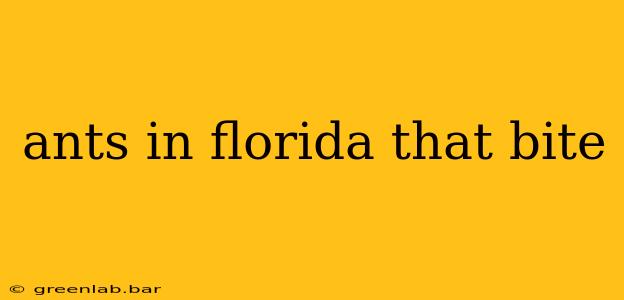Florida's warm, humid climate provides a perfect habitat for a diverse array of ant species, many of which are known for their painful stings and bites. Understanding which ants are prevalent in your area and how to identify them is crucial for preventing infestations and protecting yourself and your family. This guide will delve into some of the most common biting ants found in the Sunshine State.
Identifying Florida's Biting Ants
While many ant species in Florida might pinch or cause irritation with their mandibles, true bites involve venom injection. Here are some of the most notorious culprits:
1. Fire Ants (Solenopsis invicta & Solenopsis saevissima):
- Identification: These are arguably the most well-known biting ants in Florida. Fire ants are reddish-brown to black, with a characteristically stinging bite that feels like a burning sensation. They build mounds in open areas and are highly aggressive when disturbed. Their mounds often have a crater-like appearance.
- Bite Symptoms: Intense burning pain, followed by a pustule that can itch for days or weeks. Severe allergic reactions are possible, requiring immediate medical attention.
- Habitat: Fields, lawns, gardens, and disturbed areas.
2. Harvester Ants (Pogonomyrmex):
- Identification: Harvester ants are larger than fire ants, typically ranging from 1/4 to 1/2 inch in length. They are usually dark brown or black. Their nests are often found in dry, sandy soil and are marked by small mounds of excavated soil.
- Bite Symptoms: A sharp, painful sting, sometimes followed by localized swelling and itching. While usually not as severe as a fire ant sting, allergic reactions can occur.
- Habitat: Dry, sandy areas, often found in fields, pastures, and near buildings in rural areas.
3. Carpenter Ants (Camponotus):
- Identification: These large ants are black or dark brown and are known for nesting in wood, not eating it like termites. They can be found both indoors and outdoors. They are easily identifiable by their size (up to 1/2 inch long) and their distinctive appearance.
- Bite Symptoms: While not technically a "sting," carpenter ants can bite painfully with their strong mandibles. The bite itself can be irritating, but it's less likely to cause a serious reaction compared to fire ants or harvester ants.
- Habitat: Damp, decaying wood both inside and outside structures.
4. Odorous House Ants (Tapinoma sessile):
- Identification: Small, dark brown or black ants that emit a characteristic rotten coconut smell when crushed. They are often found indoors, especially in kitchens and bathrooms.
- Bite Symptoms: Their bite is often barely noticeable. However, some people may experience a mild, localized reaction. The smell is a more distinctive identifier than their bite.
- Habitat: Inside homes, often in kitchens, bathrooms, and other areas with moisture.
Preventing Bites and Dealing with Infestations
The best approach to dealing with biting ants is prevention. This includes:
- Eliminating food sources: Store food properly, clean up spills immediately, and take out the trash regularly.
- Reducing moisture: Repair leaks, ensure proper drainage around your home, and reduce humidity.
- Removing debris: Keep your yard clean, remove leaf litter and wood piles, and trim overhanging branches.
- Professional pest control: For severe infestations, consider contacting a pest control professional. They can identify the species and implement effective treatment strategies.
Disclaimer: This guide provides general information. If you experience a severe allergic reaction to an ant bite, seek immediate medical attention. Always consult a pest control professional for specific identification and treatment advice for ant infestations.

